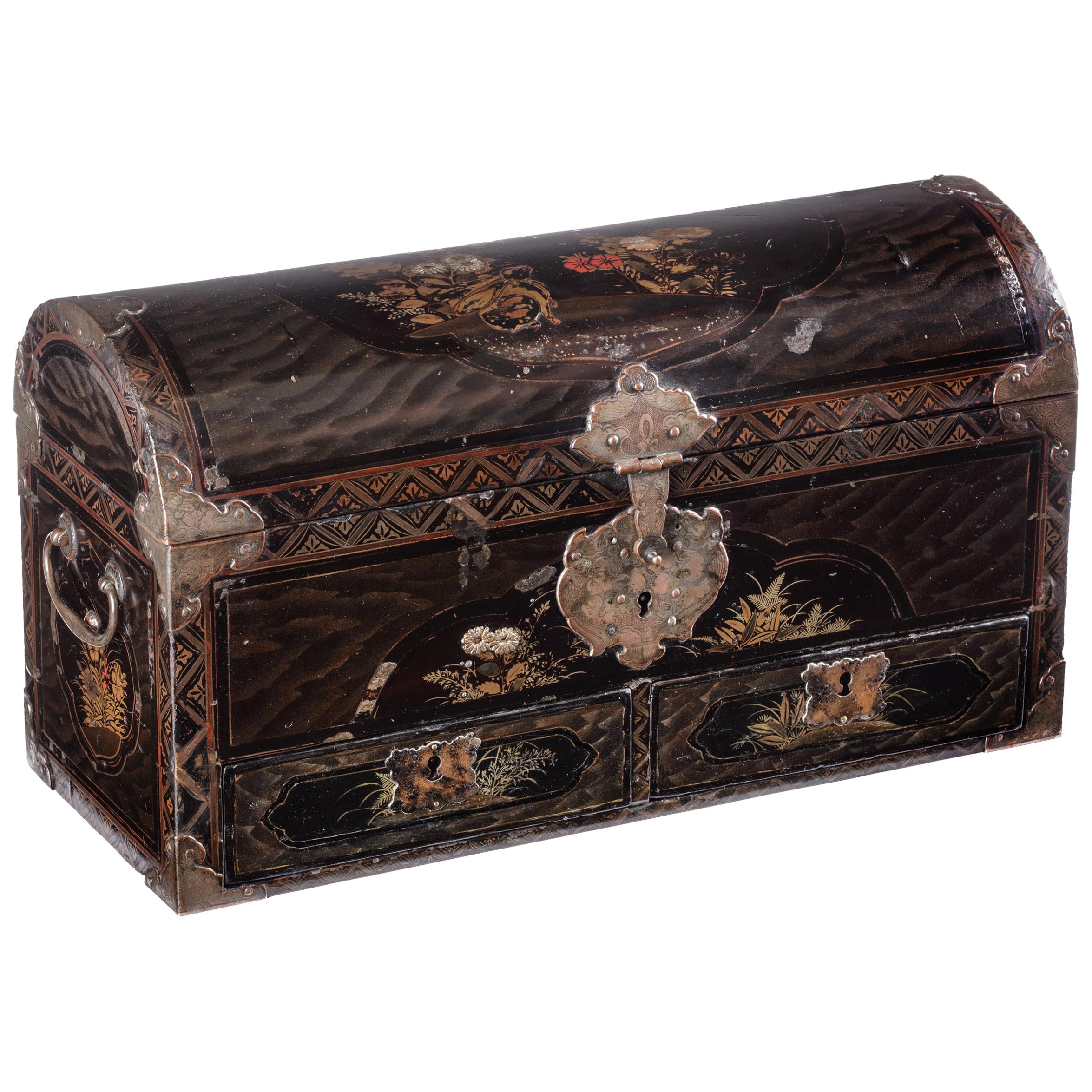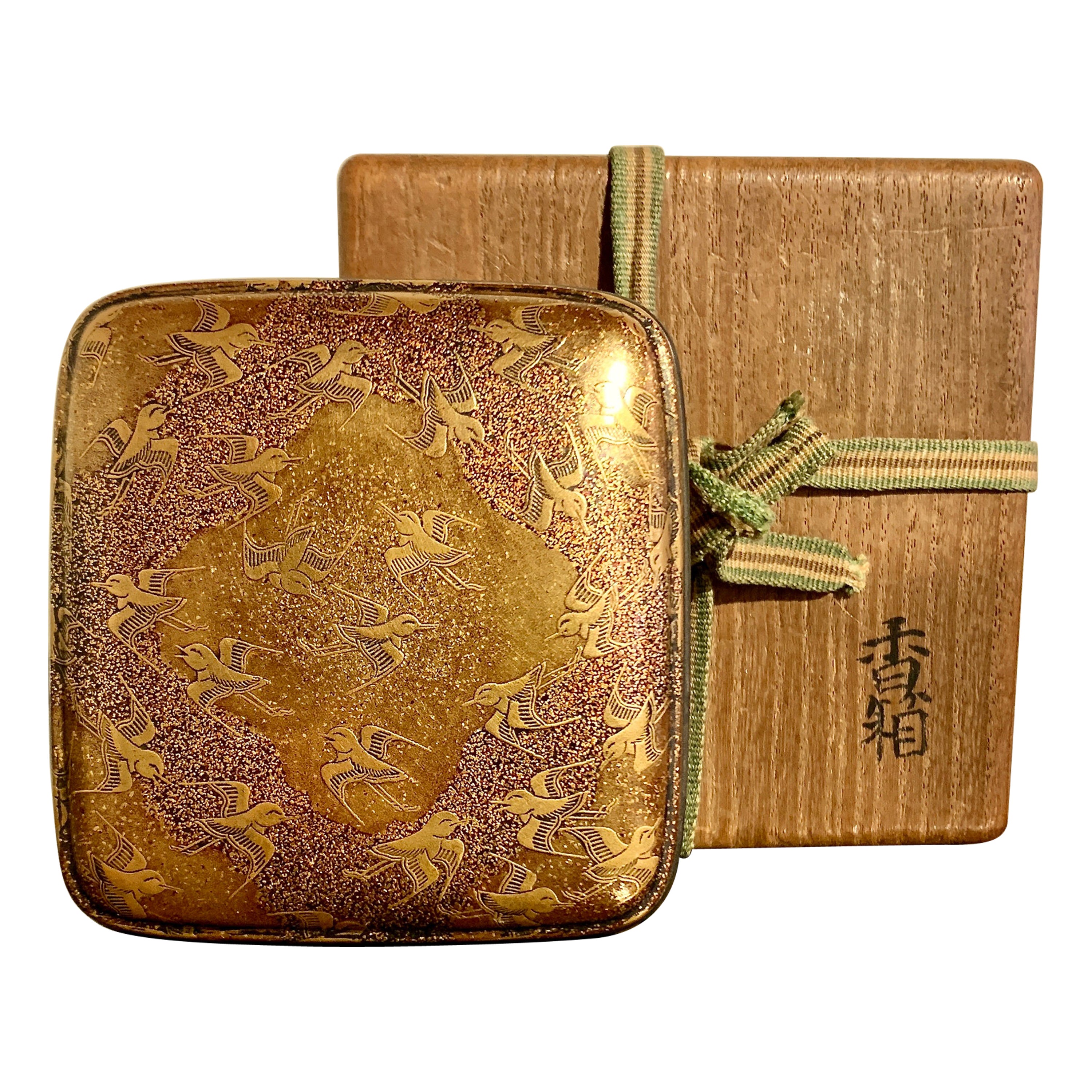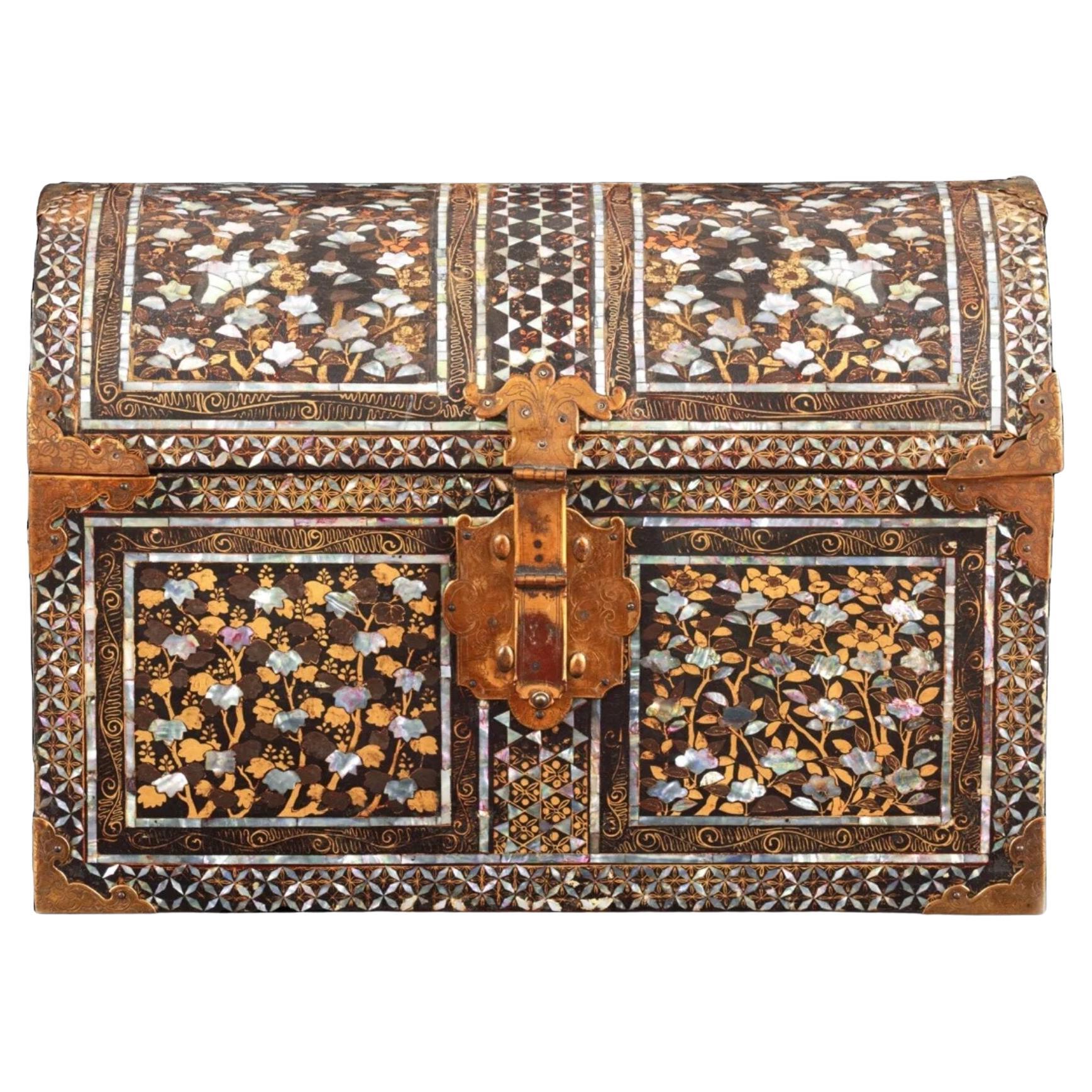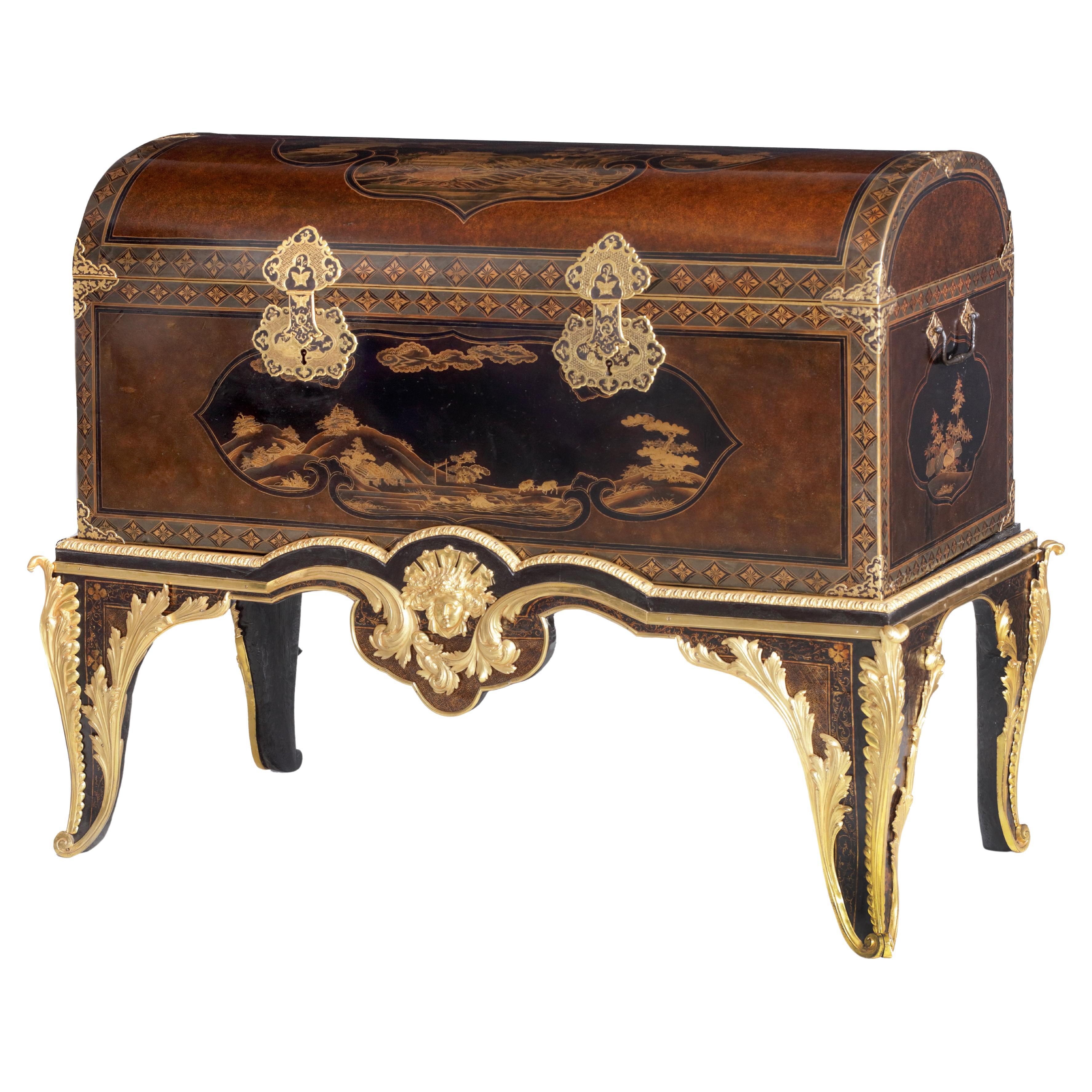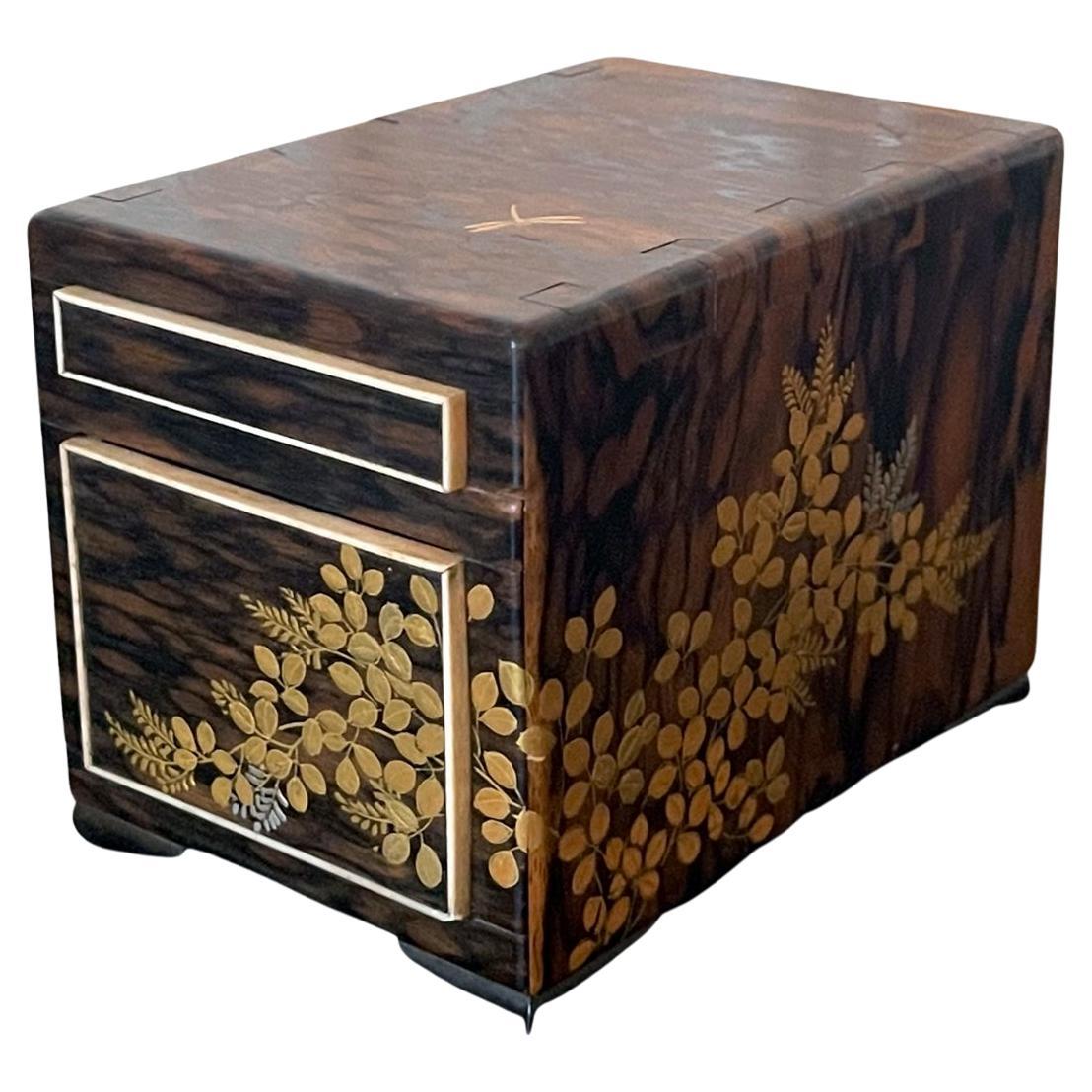Items Similar to Unique 17th Century Miniature Japanese Namban Lacquer Miniature Dollhouse Chest
Want more images or videos?
Request additional images or videos from the seller
1 of 4
Unique 17th Century Miniature Japanese Namban Lacquer Miniature Dollhouse Chest
About the Item
A unique and exceptional Japanese miniature or dollhouse export lacquered chest
Kyoto, circa 1620-1640
The chest of rectangular shape with a domed lid, decorated in Transition-style, in gold hiramaki-e on a black background within reserved lobed cartouches decorated with landscapes animated with birds and rabbits, on a shagreen or samegawa background. The borders are decorated with geometric friezes, the box with gilt-copper mounts, the interior decorated in red lacquer.
Measures: H 9.2 x W 14.5 x D 7.2 cm
This miniature is of exceptional quality and a perfect copy of the famous large size Transition-style coffers. It was most likely ordered by a Dutch lady for her dollhouse (poppenhuis), like the famous Petronella Oortman (1656-1716) doll-house, which is now one of the highlights in the collection of the Rijksmuseum Amsterdam, or Petronella Oortmans-de la Court’s (1624-1707) dollhouse in the collection of the Centraal Museum Utrecht. Sara Rothé of Amsterdam in 1743 ordered a miniature black lacquered ivory tripod table with gold chinoiserie decoration by Jurriaan Buttner (Monika Kopplin, European Lacquer, 2010, p. 56).
Other Japanned dollhouse miniatures are known, but probably all made and decorated in Europe. Apparently Japanese-style pieces were in vogue with owners of dollhouses.
Already early in the 17th century dollhouse miniature Chinese porcelain and other curiosities, also from Japan, were brought to the Netherlands, mostly through personal contacts. The VOC however, started trading in miniatures as well, and in 1638 remarks on poppeschoteltgen and poppeschaeltgen can be found in letters by officials (Jet Pijzel-Dommisse, Het Hollandse pronkpoppenhuis, Rijksmuseum 2000, pg 35-36). Also, in a in 1637 pirated Portuguese ship, a great variety of miniatures and poppegoet was found.
In VOC-letters from the 1660s, orders for Japanese lacquer cabinets can be found, that needed to be filled with “cleyn Japans porceleyn, cleijne doosgens (small boxes), coffertjen (small coffers) en andere curieusiteyten en poppegoet.” Early miniatures like the one present, could have been placed in cabinets of curiosities or dollhouses alike, but up until now it seems that none have survived, making this chest unique.
- Dimensions:Height: 3.63 in (9.2 cm)Width: 5.71 in (14.5 cm)Depth: 2.84 in (7.2 cm)
- Style:Edo (Of the Period)
- Materials and Techniques:
- Place of Origin:
- Period:
- Date of Manufacture:1620-1640
- Condition:Wear consistent with age and use.
- Seller Location:Amsterdam, NL
- Reference Number:1stDibs: LU5458222106162
About the Seller
5.0
Vetted Seller
These experienced sellers undergo a comprehensive evaluation by our team of in-house experts.
Established in 1985
1stDibs seller since 2020
19 sales on 1stDibs
Typical response time: 2 hours
- ShippingRetrieving quote...Ships From: Amsterdam, Netherlands
- Return PolicyA return for this item may be initiated within 7 days of delivery.
More From This SellerView All
- Fine Japanese Namban Lacquer Jewelry Casket, 17th CenturyLocated in Amsterdam, NLJapanese Namban lacquer transition-style coffer with two drawers Kyoto/Nagasaki, circa 1650 The cartouches with gilt and red decorations of leaves...Category
Antique 17th Century Japanese Edo Lacquer
MaterialsCypress
- Large Japanese Namban Lacquer Coffer Arqueta, 16th CenturyLocated in Amsterdam, NLA large Japanese Namban lacquer arqueta coffer for the Portuguese market Kyoto, Momoyama-period, late 16th century In Hinoki cypress lacquered in ...Category
Antique 16th Century Japanese Decorative Boxes
MaterialsMother-of-Pearl, Wood
- Superb Late 16th Century Signed Colonial Japanese Namban Export Lacquer CofferLocated in Amsterdam, NLSuperb late 16th century signed colonial Japanese Namban export lacquer coffer Momoyama period, late 16th/early 17th century, inscribed 'Arisato' on the bottom H. 30.5 x W. 43...Category
Antique 16th Century Japanese Lacquer
MaterialsCedar, Lacquer
- 17th-Century Japanese Namban Lacquer Coffer on French Stand, Possibly by BoulleBy André-Charles BoulleLocated in Amsterdam, NLAn impressive and large Japanese 'Namban' transition-style lacquer coffer with fine gilt copper mounts on a French Re´gence base, possibly by André-Charles Boulle (1642-1732) Kyot...Category
Antique 17th Century Japanese Lacquer
MaterialsBrass, Ormolu
- Rare 17th Century Japanese Export Lacquer Medical Instrument BoxLocated in Amsterdam, NLA rare Japanese export lacquer medical instrument box Edo-period, 1650-1700 L. 19 x W. 6 x H. 8.5 cm This unconventionally shaped lacquer b...Category
Antique 17th Century Japanese Edo Lacquer
MaterialsGold
- 17th Century Japanese Export Lacquer Cabinet with Depiction the Dutch TradepostLocated in Amsterdam, NLA highly important Japanese export lacquer cabinet with depiction of the Dutch East India Company tradepost Deshima and the annual Dutch delegation on its way to the Shogun in Edo Edo period, circa 1660-1680 H. 88 x W. 100.5 x D. 54 cm This cabinet includes a later European japanned stand, but also a modern powder-coated steel frame. The latter can be designed and added to your specific needs. The sides and front of the rectangular two-door cabinet are embellished in gold and silver hiramaki-e and takamaki-e on a black roiro lacquer ground with a continuous design. The two doors depict a long procession of numerous figures travelling on foot and horseback along buildings and a pagoda into a mountainous landscape. This is the annual court journey, Hofreis, of the Dutch from Nagasaki to the Shogun’s court in Edo. Three horseback riders are dressed as Dutch merchants and a fourth figure, probably het Opperhoofd, is seen inside a palanquin, norimon. Just about to cross the bridge, two men are carrying a cabinet like the present one. Many Japanese figures on either side of the procession are engaged in various activities; some play musical instruments on board of small boats, others are fishing; figures inside buildings are depicted playing go, and farmers are tending to their rice paddocks. The upper part of the right door shows a large mansion, probably the local daimyo’s castle, with men kneeling before a man in the central courtyard. The court journey fits in with the foreign policy of the shogunate which accorded a role to the VOC alongside China, Korea, and the Ryukyu Islands who also had to pay tribute. However, the VOC employees were traders, having low status in Japan’s social hierarchy, and they were received with less deference than were the state embassies from Korea and the Ryukyu Islands. Nevertheless, the contacts with the Dutch were a welcome source of information to the Shogun about Europe and European science and technology. The left side of the cabinet depicts, in mirror image, a rare view of the artificial fan-shaped Deshima Island, the trading post for the Dutch in Japan. The island, where the Dutch flag flies, is surrounded by small Japanese boats and an anchored three-masted fluyt (cargo ship), flying Dutch flags, with on the stern the VOC monogram. On the bottom right a busy street of Nagasaki is shown, bordered by shops and leading up to the stone bridge. On the island the trees are beautifully painted, two cows can be seen, and the flagpole, all in very fine detail. Dutchmen and enslaved Malay are visible outside the buildings and two Japanese figures, probably guards, sit in a small hut in the centre. A maximum of fifteen to twenty Dutchmen lived on the island at any time and soldiers or women were not allowed. Restrictions on Deshima were tight, and the merchants were only allowed to leave the island by special permission. The Opperhoofd had to be replaced every year, and each new Opperhoofd had to make a court journey to pay tribute, present gifts, and to obtain permission to Margaret Barclay eep on trading. In the distance, many birds fly above the hills and a four-story pagoda can be seen. The right side of the cabinet is painted with other horse riders and their retinue journeying through mountains. The pair of doors to the front open to reveal ten rectangular drawers. The drawers are decorated with scenes of birds in flight and landscapes with trees and plants. The reverse of the left door with two thatched buildings, one with a ladder, underneath a camelia tree with large blooms; the right door with a three-story pagoda nestled among trees and both doors with a flying phoenix, ho-oo bird. The cabinet, with elaborately engraved gilt copper mounts, hinges, lock plates and brass handles, is raised on an 18th-century English japanned wood stand. A pair of large cabinets...Category
Antique 17th Century Japanese Edo Lacquer
MaterialsCopper, Gold
You May Also Like
- Japanese Lacquer Incense Box, Kogo, Momoyama or Edo Period, 16th/17th CenturyLocated in Austin, TXA wonderful Japanese lacquer incense box, kogo, with a design of sparrows in flight, late Momoyama or early Edo Period, circa 1600, Japan. The small box, called a kogo, was used t...Category
Antique Early 17th Century Japanese Edo Lacquer
MaterialsGold, Pewter
- Fine Miniature Japanese Kodansu with Lacquer InlaysLocated in Atlanta, GAA fine Japanese miniature kodansu constructed from Kaki wood (Persimmon) circa 19th century, late Meiji period. With its expressive exotic wood grains and exposed tenon construction,...Category
Antique Late 19th Century Japanese Meiji Lacquer
MaterialsWood
- Japan Red Lacquered Box 19th centuryLocated in Beuzevillette, FRBeautiful Japanese box in red lacquered wood. The lid is decorated with golden herons and flowering tree branches and signed by the artist. Black flowers are painted around the box. ...Category
Antique Late 19th Century Decorative Boxes
MaterialsWood
- Japan Red Lacquered Box 19th centuryLocated in Beuzevillette, FRBeautiful Japanese box in red lacquered wood; 19th century The lid is decorated with a landscape with a bird, trees and a setting sun. The inside of the box is covered with a lacque...Category
Late 20th Century Decorative Boxes
MaterialsWood
- Japanese Lacquer Hokai Box, 19th CenturyLocated in Pasadena, CAThis is a good example of a traditional Japanese Hokai shell storage box for the Kai-awase game. This box is well-detailed in chased brass appliques and makie. The box is in overall ...Category
Antique Late 19th Century Japanese Japonisme Lacquer
MaterialsWood, Lacquer
- Japan Red Lacquered Box 19th CenturyLocated in Beuzevillette, FRBeautiful Japanese box in red lacquered wood. The lid is decorated with flowering magnolia branches and signed by the artist. The inside of the box is covered with a paint loaded wit...Category
Antique Late 19th Century Jewelry Boxes
MaterialsWood
Recently Viewed
View AllMore Ways To Browse
Lacquer Lacquer Cabinet
Black Lacquer Table
Black Lacquered Tables
Lacquer Red
Red Lacquer Furniture
Brown Lacquered Cabinet
Black Lacquer Cabinet
Black Gold Lacquer
Gold And Black Lacquer
Red Black Lacquer
Black And Red Lacquer
Lacquered Chinoiserie
Chinoiserie Lacquered Furniture
Lacquered Chinese Table
Lacquered Table China
Lacquer Small Table
Red Lacquer Table
Red Lacquered Table
